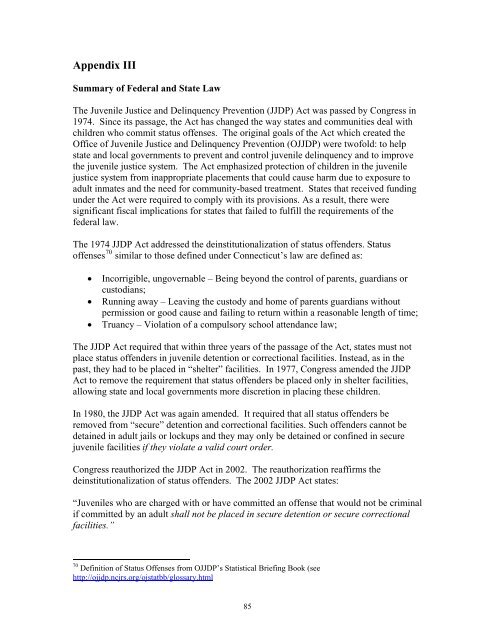FWSN-advisorybd-repo.. - The Connecticut Juvenile Justice Alliance
FWSN-advisorybd-repo.. - The Connecticut Juvenile Justice Alliance
FWSN-advisorybd-repo.. - The Connecticut Juvenile Justice Alliance
Create successful ePaper yourself
Turn your PDF publications into a flip-book with our unique Google optimized e-Paper software.
Appendix III<br />
Summary of Federal and State Law<br />
<strong>The</strong> <strong>Juvenile</strong> <strong>Justice</strong> and Delinquency Prevention (JJDP) Act was passed by Congress in<br />
1974. Since its passage, the Act has changed the way states and communities deal with<br />
children who commit status offenses. <strong>The</strong> original goals of the Act which created the<br />
Office of <strong>Juvenile</strong> <strong>Justice</strong> and Delinquency Prevention (OJJDP) were twofold: to help<br />
state and local governments to prevent and control juvenile delinquency and to improve<br />
the juvenile justice system. <strong>The</strong> Act emphasized protection of children in the juvenile<br />
justice system from inappropriate placements that could cause harm due to exposure to<br />
adult inmates and the need for community-based treatment. States that received funding<br />
under the Act were required to comply with its provisions. As a result, there were<br />
significant fiscal implications for states that failed to fulfill the requirements of the<br />
federal law.<br />
<strong>The</strong> 1974 JJDP Act addressed the deinstitutionalization of status offenders. Status<br />
offenses 70 similar to those defined under <strong>Connecticut</strong>’s law are defined as:<br />
• Incorrigible, ungovernable – Being beyond the control of parents, guardians or<br />
custodians;<br />
• Running away – Leaving the custody and home of parents guardians without<br />
permission or good cause and failing to return within a reasonable length of time;<br />
• Truancy – Violation of a compulsory school attendance law;<br />
<strong>The</strong> JJDP Act required that within three years of the passage of the Act, states must not<br />
place status offenders in juvenile detention or correctional facilities. Instead, as in the<br />
past, they had to be placed in “shelter” facilities. In 1977, Congress amended the JJDP<br />
Act to remove the requirement that status offenders be placed only in shelter facilities,<br />
allowing state and local governments more discretion in placing these children.<br />
In 1980, the JJDP Act was again amended. It required that all status offenders be<br />
removed from “secure” detention and correctional facilities. Such offenders cannot be<br />
detained in adult jails or lockups and they may only be detained or confined in secure<br />
juvenile facilities if they violate a valid court order.<br />
Congress reauthorized the JJDP Act in 2002. <strong>The</strong> reauthorization reaffirms the<br />
deinstitutionalization of status offenders. <strong>The</strong> 2002 JJDP Act states:<br />
“<strong>Juvenile</strong>s who are charged with or have committed an offense that would not be criminal<br />
if committed by an adult shall not be placed in secure detention or secure correctional<br />
facilities.”<br />
70 Definition of Status Offenses from OJJDP’s Statistical Briefing Book (see<br />
http://ojjdp.ncjrs.org/ojstatbb/glossary.html<br />
85
















